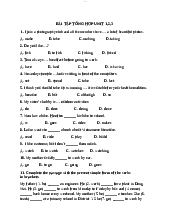





Preview text:
Walking With Dinosaurs IELTS Reading Answers with Explanation
Luyện tập đê IELTS Reading Practice với passage Walking With Dinosaurs được lấy từ
cuốn sach IELTS IELTS Trainer - Test 1 - Passage 1 với trải nghiệm thi IELTS trên máy
và giải thích đáp án chi tiết bằng Linearthinking, kèm list từ vựng IELTS cần học trong bài đọc. DOL IELTS Đình Lực 28/02/2022 Làm Bài Xem giải thích Từ vựng Bài đọc (reading passage) Walking with dinosaurs
Peter L. Falkingham and his colleagues at Manchester University are developing techniques which look
set to revolutionize our understanding of how dinosaurs and other extinct animals behaved.
The media image of palaeontologists who study prehistoric life is often of field workers camped in the
desert in the hot sun, carefully picking away at the rock surrounding a large dinosaur bone. But Peter
Falkingham has done little of that for a while now. Instead, he devotes himself to his computer. Not
because he has become inundated with paperwork, but because he is a new kind of palaeontologist: a computational palaeontologist.
What few people may consider is that uncovering a skeleton, or discovering a new species, is where the
research begins, not where it ends. What we really want to understand is how the extinct animals and
plants behaved in their natural habitats. Drs Bill Sellers and Phil Manning from the University of
Manchester use a ‘genetic algorithm’ – a kind of computer code that can change itself and ‘evolve’ – to
explore how extinct animals like dinosaurs, and our own early ancestors, walked and stalked.
The fossilized bones of a complete dinosaur skeleton can tell scientists a lot about the animal, but they do
not make up the complete picture and the computer can try to fill the gap. The computer model is given a
digitized skeleton, and the locations of known muscles. The model then randomly activates the muscles.
This, perhaps unsurprisingly, results almost without fail in the animal falling on its face. So the computer
alters the activation pattern and tries again … usually to similar effect. The modeled dinosaurs quickly
‘evolve’. If there is any improvement, the computer discards the old pattern and adopts the new one as
the base for alteration. Eventually, the muscle activation pattern evolves a stable way of moving, the best
possible solution is reached, and the dinosaur can walk, run, chase or graze. Assuming natural selection
evolves the best possible solution too, the modeled animal should be moving in a manner similar to its
now-extinct counterpart. And indeed, using the same method for living animals (humans, emu and
ostriches) similar top speeds were achieved on the computer as in reality. By comparing their cyberspace
results with real measurements of living species, the Manchester team of palaeontologists can be
confident in the results computed showing how extinct prehistoric animals such as dinosaurs moved.
The Manchester University team have used the computer simulations to produce a model of a giant meat-
eating dinosaur. It is called an acrocanthosaurus which literally means ‘high spined lizard’ because of the
spines which run along its backbone. It is not really known why they are there but scientists have
speculated they could have supported a hump that stored fat and water reserves. There are also those
who believe that the spines acted as a support for a sail. Of these, one half think it was used as a display
and could be flushed with blood and the other half think it was used as a temperature-regulating device. It
may have been a mixture of the two. The skull seems out of proportion with its thick, heavy body because
it is so narrow and the jaws are delicate and fine. The feet are also worthy of note as they look surprisingly
small in contrast to the animal as a whole. It has a deep broad tail and powerful leg muscles to aid
locomotion. It walked on its back legs and its front legs were much shorter with powerful claws.
Falkingham himself is investigating fossilized tracks, or footprints, using computer simulations to help
analyze how extinct animals moved. Modern-day trackers who study the habitats of wild animals can tell
you what animal made a track, whether that animal was walking or running, sometimes even the sex of
the animal. But a fossil track poses a more considerable challenge to interpret in the same way. A crucial
consideration is knowing what the environment including the mud, or sediment, upon which the animal
walked was like millions of years ago when the track was made. Experiments can answer these questions
but the number of variables is staggering. To physically recreate each scenario with a box of mud is
extremely time-consuming and difficult to repeat accurately. This is where computer simulation comes in.
Falkingham uses computational techniques to model a volume of mud and control the moisture content,
consistency, and other conditions to simulate the mud of prehistoric times. A footprint is then made in the
digital mud by a virtual foot. This footprint can be chopped up and viewed from any angle and stress
values can be extracted and calculated from inside it. By running hundreds of these simulations
simultaneously on supercomputers, Falkingham can start to understand what types of footprint would be
expected if an animal moved in a certain way over a given kind of ground. Looking at the variation in the
virtual tracks, researchers can make sense of fossil tracks with greater confidence.
The application of computational techniques in palaeontology is becoming more prevalent every year. As
computer power continues to increase, the range of problems that can be tackled and questions that can be answered will only expand. Câu hỏi (questions ) Question 1 - 6
Do the following statements agree with the information given in the Reading Passage?
In following statements below, choose
YES if the statement agrees with the information
NO if the statement contradicts the information
NOT GIVEN if it is impossible to say what the writer thinks about this 1
In his study of prehistoric life, Potor Falkinghom rarely spends time on outdoor research those days. 2
Several attempts are usually needed before the computer model of a dinosaur used by Sellers and
Manning manages to stay upright. 3
When the Sellers and Manning computer model was used for people, it showed them moving faster
than they are physically able to. 4
Some palaeontologists have expressed reservations about the conclusions reached by the
Manchester team concerning the movement of dinosaurs. 5
An experienced tracker can analyse fossil footprints as easily as those made by live animals. 6
Research carried out into the composition of prehistoric mud has been found to be inaccurate. Question 7 - 9
ChooseNO MORE THAN ONE WORDfrom the passage for each answer. 7 8
Dinosaur's name comes from spines. One theory: they were necessary to hold up a 7 which helped control body heat. 9 Skull is 8 compared with rest of body. 9
made easier by wide tail and highly developed muscles in legs. Question 10 - 13
Complete the flow-chart below
Write NO MORE THAN TWO WORDS for each answer
Peter Falkingham's computer model STEP 01
Mud is simulated with attention to is texture and thickness and how much 10 it contains. STEP 02
A virtual foot produces a footprint in the mud. STEP 03
The footprint is dissected and examined from all angles. STEP 04 Levels of 11
are measured with the footprint. STEP 05
Multiple simulations relate footprints to different types of 12 STEP 06
More accurate interpretation of 13 is possible
Answer key (đáp án và giải thích) 1 Yes Xem Xe m full g i full g ả i i ả it h t í h c í h c 2 Yes Xem Xe m full g i full g ả i i ả it h t í h c í h c 3 No Xem Xe m full g i full g ả i i ả it h t í h c í h c 4 Not Given Xem Xe m full g i full g ả i i ả it h t í h c í h c 5 No Xem Xe m full g i full g ả i i ả it h t í h c í h c 6 Not Given Xem Xe m full g i full g ả i i ả it h t í h c í h c 7 sail Xem Xe m full g i full g ả i i ả it h t í h c í h c 8 narrow Xem Xe m full g i full g ả i i ả it h t í h c í h c 9 locomotion Xem Xe m full g i full g ả i i ả it h t í h c í h c 10 moisture Xem Xe m full g i full g ả i i ả it h t í h c í h c 11 stress Xem Xe m full g i full g ả i i ả it h t í h c í h c 12 ground Xem Xe m full g i full g ả i i ả it h t í h c í h c 13 fossil tracks Xem Xe m full g i full g ả i i ả it h t í h c í h c
Hãy cùng DOL khám phá kho đề thi IELTS Reading Practice với lời giải thích chi tiết ở đây ->




